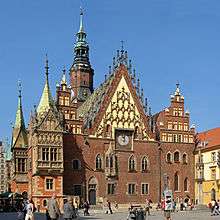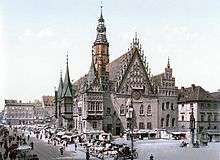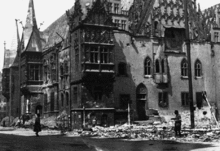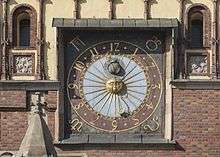Wrocław Town Hall
The Old Town Hall (Polish: Stary Ratusz, German: Breslauer Rathaus) of Wrocław stands at the center of the city’s Market Square (rynek).[1] The Gothic town hall built from the 13th century is one of the main landmarks of the city.







The Old Town Hall's long history reflects developments that have taken place in the city since its initial construction. The town hall serves the city of Wroclaw and is used for civic and cultural events such as concerts held in its Great Hall. In addition, it houses a museum and a basement restaurant.
History
The town hall was developed over a period of about 250 years, from the end of 13th century to the middle of 16th century. The structure and floor plan changed over this extended period in response to the changing needs of the city. The exact date of the initial construction is not known. However, between 1299 and 1301 a single-storey structure with cellars and a tower called the consistory was built. The oldest parts of the current building, the Burghers’ Hall and the lower floors of the tower, may date to this time. In these early days the primary purpose of the building was trade rather than civic administration activities.
Between 1328 and 1333 an upper storey was added to include the Council room and the Aldermen’s room. Expansion continued during the 14th century with the addition of extra rooms, most notably the Court room. The building became a key location for the city’s commercial and administrative functions.
The 15th and 16th centuries were times of prosperity for Wrocław as was reflected in the rapid development of the building during that period. The construction program gathered momentum, particularly from 1470 to 1510, when several rooms were added. The Burghers’ Hall was re-vaulted to take on its current shape, and the upper story began to take shape with the development of the Great Hall and the addition of the Treasury and Little Treasury.
Further innovations during the 16th century included the addition of the city’s Coat of arms (1536), and the rebuilding of the upper part of the tower (1558–59). This was the final stage of the main building program. By 1560, the major features of today’s Old Town Hall were established.
The rapid development of the city meant that the Town Hall had to accommodate more administrative functions. During the 17th century, the allocation of space within the building was changed to ensure that all the town offices could be housed there. The ground floor was allocated for military purposes and the general public had access only to the basement, where alcohol was served.
The second half of the 17th century was a period of decline for the city, and this decline was reflected in the Old Town Hall. Perhaps by way of compensation, efforts were made to enrich the interior decorations of the hall. In 1741, Wrocław became a part of Prussia, and the power of the City diminished. Much of the Town Hall was allocated to administering justice.
During the 19th century there were two major changes. The courts moved to a separate building, and the Town Hall became the site of the city council and supporting functions. There was also a major program of renovation because the building had been neglected and was covered with creeping vines. The town hall now has several en-Gothic features including some sculptural decoration from this period.
In the early years of the 20th century improvements continued with various repair work and the addition of the Little Bear statue in 1902. During the 1930s, the official role of the Town Hall was reduced and it was converted into a museum.
Toward the end of World War II, the Town Hall suffered minor damage – an aerial bomb pierced the roof (but did not explode) and some sculptural elements were lost.
Restoration work began in the 1950s following a period of research, and this conservation effort continued throughout the 20th century. It included refurbishment of the clock on the east facade.
Today, the Old Town Hall is open to visitors as the Museum of Bourgeois Art[2] and is also the venue for temporary exhibitions and cultural events.
Architecture and Chambers
The Old Town Hall sits in the Market square at an angle. It is considered as a fine example of bourgeois Gothic architecture. Originally, it was a single story building and was expanded over the years. The current form dates from the late 15th century with ornaments on the Eastern and Southern facades. The entrance is from the western side and it leads into the Burghers’ Hall.
The Burghers’ Hall dates from the turn of the 14th century when it housed public gatherings and ceremonies. It was later used for commercial purposes. Today, it includes a map of Wroclaw (a modern copy of a 16th-century map).
The next room is the Aldermans’ Hall, also known as the Court Room. It dates from 1299, and was used by members of the municipality. It has a special podium for the administration of justice. Beyond that lies the Council Chamber, dating from the first half of the 14th century. Here, important city decisions were made and you can find a Renaissance portal from 1528, probably painted by Andreas Walter. Until 1945, this room was richly decorated but some of the elements, such as wood paneling, furniture, and paintings, have been irretrievably lost. The wall paintings and baroque cocklestove, however, have survived.
Next is the Council Office, where the council secretary and receiver once worked. This was a popular office for clerks and was seen as a high-status profession. Architecturally, it still has its padded doors from 1429 and portraits of eminent town councilors.
Upstairs is the Grand Hall, which dates from the second half of the 15th century. Here, official ceremonies took place.
See also
Bibliography
- Ślusarski, Andrzej; Stefan Arczyński; Krystyna Januszkiewicz (1985). The Wratislavian town hall: a guide book. the History Museum in Wrocław. ISBN 83-905227-4-8.
- Urlich-Kornacka, Małgorzata (2008). A guide to Wrocław. Wrocław: Via Nova. ISBN 978-83-60544-59-4.
- Harasimowicz, Jan (2006). Encyklopedia Wrocławia, wydanie trzecie. Wrocław: Wydawnictwo Dolnośląskie. ISBN 83-7384-561-5.
- Bukowski, Marcin (1985). Wrocław z lat 1945-1952: Zniszczenia i dzieło odbudowy. Państwowe Wydawnictwo Naukowe. ISBN 83-01-05849-8.
References
- "Town Hall". Retrieved 4 January 2015.
- Paweł Szymula. "www.en.muzeum.miejskie.wroclaw.pl". Retrieved 4 January 2015.
External links
![]()
- Ratusz - Rathaus Breslau na portalu polska-org.pl (in Polish)